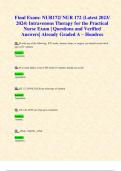Exam (elaborations)
Test Bank For Lippincott Illustrated Reviews: Pharmacology 7th Edition by Karen Whalen | 9781496384133 | Chapter 1-48 |All Chapters with Answers and Rationals
Title: Lippincott Pharmacology Illustrated Reviews 7th Edition Whalen Test Bank ISBN: 9781496384133 Number of Pages: 509 Edition: 7th Author: Whalen Number of Chapters: 48 Supercharge your pharmacology understanding with the Test Bank for Lippincott Pharmacology Illustrated Reviews, 7th Edi...
[Show more]












